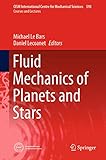Fluid Mechanics of Planets and Stars [electronic resource] / edited by Michael Le Bars, Daniel Lecoanet.
Contributor(s): Le Bars, Michael [editor.] | Lecoanet, Daniel [editor.]
| Lecoanet, Daniel [editor.] | SpringerLink (Online service)
| SpringerLink (Online service) .
.
Material type:  BookSeries: CISM International Centre for Mechanical Sciences, Courses and Lectures: 595Publisher: Cham : Springer International Publishing : Imprint: Springer, 2020Edition: 1st ed. 2020.Description: VII, 241 p. 79 illus., 54 illus. in color. online resource.Content type: text Media type: computer Carrier type: online resourceISBN: 9783030220747.Subject(s): Fluid mechanics
BookSeries: CISM International Centre for Mechanical Sciences, Courses and Lectures: 595Publisher: Cham : Springer International Publishing : Imprint: Springer, 2020Edition: 1st ed. 2020.Description: VII, 241 p. 79 illus., 54 illus. in color. online resource.Content type: text Media type: computer Carrier type: online resourceISBN: 9783030220747.Subject(s): Fluid mechanicsInternal Waves and Tides in Stars and Giant Planets -- Waves & Convection in Stellar Astrophysics -- Internal Waves in the Atmosphere and Ocean: Instability Mechanisms -- Rotational Dynamics of Planetary Cores: Instabilities Driven by Precession, Libration and Tides -- Fluid Dynamics of Earth's Core: Geodynamo, Inner Core Dynamics, Core Formation -- A Brief Introduction to Turbulence in Rotating and Stratified Fluids.
This book explores the dynamics of planetary and stellar fluid layers, including atmospheres, oceans, iron cores, and convective and radiative zones in stars, describing the different theoretical, computational and experimental methods used to study these problems in fluid mechanics, including the advantages and limitations of each method for different problems. This scientific domain is by nature interdisciplinary and multi-method, but while much effort has been devoted to solving open questions within the various fields of mechanics, applied mathematics, physics, earth sciences and astrophysics, and while much progress has been made within each domain using theoretical, numerical and experimental approaches, cross-fertilizations have remained marginal. Going beyond the state of the art, the book provides readers with a global introduction and an up-to-date overview of relevant studies, fully addressing the wide range of disciplines and methods involved. The content builds on the CISM course “Fluid mechanics of planets and stars”, held in April 2018, which was part of the research project FLUDYCO, supported by the European Research Council (ERC) under the European Union's Horizon 2020 research and innovation program.


There are no comments for this item.